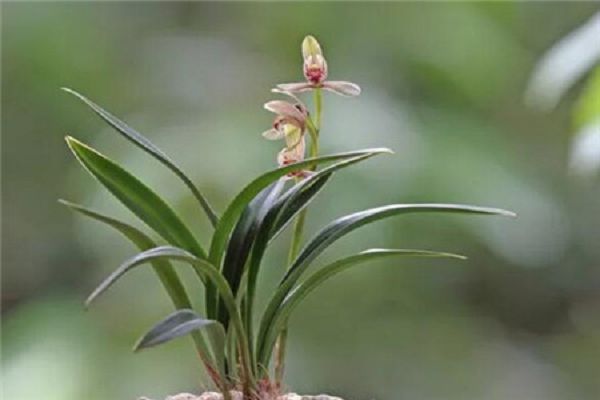The gentleman orchid hasn't grown leaves since summer. What's going on?

It has not been as long as half a year since the Summer Solstice. Personally, I think the biggest reason is that stiff seedlings are caused by problems with the root system and the basin soil. The growth of plant leaves depends on whether the root system is good or not, the supply mechanism of good root plant nutrients is normal, and the leaves grow naturally, on the contrary, if the root system is injured by external factors, it will be in a state of self-protection because it loses the function of absorbing external nutrients and is unable to provide for its growth and consumption, so that the leaves are in a state of immortality and immortality. We migratory birds and flower valley differentiate them into rigid seedlings.
Map of over-wet and stiff seedlings in basin soil
Since summer, but I don't agree. According to the season: the summer is 6, 7, 8, but the law of plant disease is different, it is found that the disease and the disease are essentially different in time. Often the onset is earlier than the discovery, so the cause of the disease can be pushed forward, which should be March, April and May in spring.
In the north of China from March to May, due to the dry air, the initial warm and cold, coupled with the lack of window ventilation in winter, the indoor air circulation is very poor, it is often difficult to water, and the root system is often in a semi-wet and airtight state. When the new roots are wet, they are prone to rot and retreat. At this time, the basin soil should be kept dry and watering should be controlled.
Root and seedling map of nitrate accumulation
At this time, if you leave the room too early, it can easily lead to dry leaves, sprain, sunburn or root injury.
Generally speaking: from April in spring, indoor diseases of all kinds of flowers began to break out in winter, especially rotting roots and seedlings caused by improper watering.
Improper basin soil
Gentleman orchid likes loose, fertile, permeable and slightly acidic soil. Northern flower friends often use ferrous sulfate with water to improve the over-alkali problem of basin soil. But ignore the harm caused by the excessive use of ferrous sulfate! If ferrous sulfate is used for a long time, it will accumulate a large amount of nitrate in the basin soil, and it is easy to hurt the root if it exceeds 0.3%. Coupled with the improper fertilization of flower friends, it often makes the root tip shriveled and shrunken hollow to stop sprouting new roots; in addition, the pot has not been changed for a long time, and the pot soil has been consolidated into blocks for a long time. Most novice flower friends are planted once, no longer manage, wait for good growth and flowering ideas! Laissez-faire, do not apply when lack of fertilizer, do not loosen the soil when impermeable, etc., will make it difficult for the root system to grow new roots and cause stiff seedlings.
Fungal rotting roots and rigid seedlings caused by over-wet and poor ventilation in basin soil
There is also a kind of slow growth of Cymbidium, that is, the newly purchased slow seedling stage and seedling transplanting stage. Slow seedling stage, sometimes as long as half a year of the phenomenon. This is determined by the characteristics of the gentleman orchid, and its growth characteristic is that it grows roots first, then leaves. As I said at the beginning of my article, only leaves grow when roots grow.
For the emergence of stiff seedlings of the gentleman orchid and other flowers, I take off the pot to check the root. It is often found that the white tender meat roots in the short roots of Cymbidium are mostly shriveled, brown or black, so after de-potting, disinfect the rotten roots with potassium permanganate solution for half an hour, cut off the rotten roots, dry them, use rooting blisters for 12 hours, first use coarse sand and other media to promote roots, and when the new leaves of stiff seedlings begin to germinate, they will be rejuvenated with rotten leaf soil or special soil for Magnolia. Sometimes pine needles plus magnolia soil and river sand are also used. Because the root-fixing effect of the special soil is not good, you observe carefully that the plant body of the gentleman orchid cultivated in the pure special soil is not normal after watering. And I still grow well with river sand.
The phenomenon of rigid seedlings of Cymbidium is also related to poor growth caused by excessive light or long-term shading. Long-term lack of light can lead to death, with the exception of summer, the other three seasons can be given sufficient light. However, this does not have much to do with rigid seedlings, as for long-term non-fertilization is just poor growth, it is not the main cause of rigid seedlings.
Related
- Is the orchid suitable for indoor use? Is it good for the body?
- How to prevent the empty root of orchids?
- What to do after the crab claw orchid is withered?
- Why are the leaves of orchids always yellow? Fertilizing and watering.
- Can the root of the gentleman orchid be saved if it is rotten?
- Diagnosis and treatment of cotton-blowing beetle insects in Cymbidium
- There is a way for a gentleman's orchid to rot.
- What is the most suitable temperature and humidity for the orchid?
- How to raise a gentleman's orchid? Cultivation techniques of Cymbidium
- How to prepare the nutritive soil for the cultivation of Cymbidium



